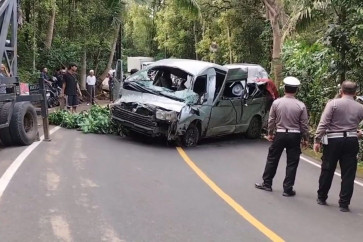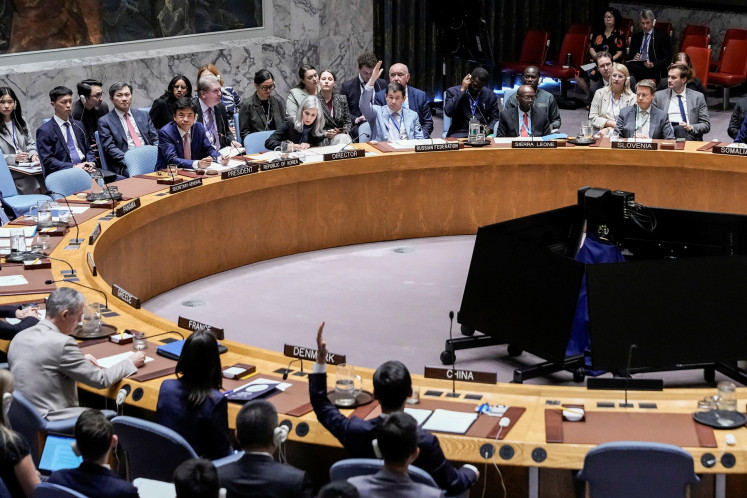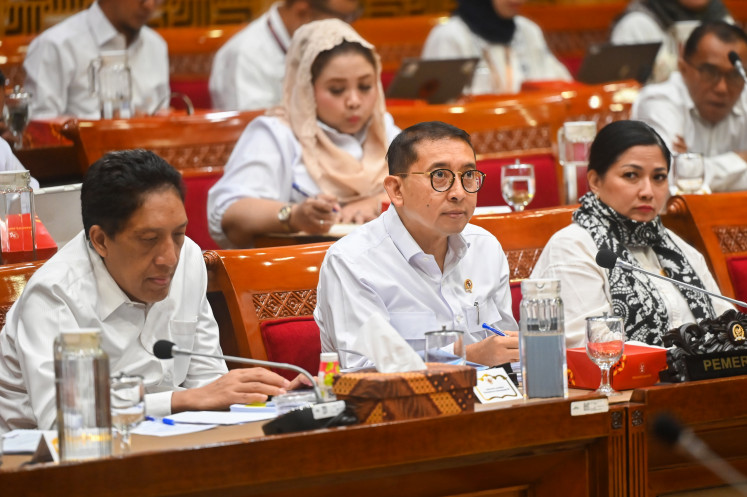Popular Reads
Top Results
Can't find what you're looking for?
View all search resultsPopular Reads
Top Results
Can't find what you're looking for?
View all search resultsBanda, the nutmeg treasure islands
The departing ship operated by state-run shipping firm PT Pelni is seen under the shadow of Gunung Api, Banda’s active volcano
Change text size
Gift Premium Articles
to Anyone
The departing ship operated by state-run shipping firm PT Pelni is seen under the shadow of Gunung Api, Banda’s active volcano.
The seven tiny Banda Islands in Maluku, located some 250 kilometers southeast of the province capital Ambon, have become such a backwater in recent decades that few people in the country or beyond either know of their existence and of their major historical importance.
It’s hard to imagine that 500 years ago they probably held a similar kind of status in international trading importance as the Gulf States do today with regard to oil.
As a result of their commercial value, they became the center of developing European colonial geopolitical tensions in the 16th century that led to an amazing land-swap involving one of the Banda Islands and another area of island real estate.
As the only source of the world’s supply of nutmeg and mace in the middle ages, the Banda Islands were one of the main driving forces behind modern European international relations and ultimately the early history of colonialism in the East Indies from the 16th century onwards.
First, the Portuguese, then the Spanish and finally the Dutch and the English competed to outdo each other in terms of seafaring technology and mapmaking skills. They were all striving to track down the illusive source of eastern spices that found their way to the lucrative European markets only via traders and merchants in the Middle East.
In the Elizabethan days, nutmeg was more valuable than gold by weight, as the nutmeg nut was believed to be a cure for the dreaded plague that was devastating populations across Europe at that time.
With so much potential wealth at stake, it was only a matter of time before one of the European powers would subjugate the Banda Islands in an attempt to create a monopoly controlling the sale of nutmeg and mace.
In the face of stiff opposition, this goal was eventually achieved by the Dutch East Indies Company (VOC). Founded in 1602, the VOC gradually undermined the developing English presence in the East Indies over the next 20 years. The Bandanese natives paid a terrible price for resisting the Dutch — almost all were either slaughtered or transported in dreadful conditions to Java and a life of slavery.
One small group managed to escape the Dutch in their long-boats, heading southeast into the open ocean, and finally settling on Kei Besar, one of the Kei Islands chain close to Papua. In the village of Banda Elat, on Kei Besar, the last and probably dying trace of the original Bandanese language can still be found today.
The English had tried to resist the Dutch by holding out on the furthermost island of Run, but they were eventually worn down by starvation and forced into capitulation. However, England never accepted Dutch sovereignty; at least not until the Treaty of Breda was finally signed on April 18, 1667.
This agreement gave England control of the small island of Manhattan (at that time known as New Amsterdam) in return for English acquiescence to the Dutch gaining sovereignty over Run, thereby changing the course of history on the other side of the globe.
Women prepare their food stalls in anticipation of the ship’s arrival.
But the economic importance of the Bandas was only fleeting. With the Napoleonic wars raging across Europe, the English returned to the Bandas in the early 19th century, temporarily taking over control from the Dutch. This gave the English an opportunity to uproot hundreds of valuable nutmeg seedlings and transport them to their own colonies in Ceylon and Singapore, breaking forever the Dutch monopoly and consigning the Bandas to economic decline and irrelevance.
The Islands momentarily returned to prominence in the 1930s, when the Dutch colonial government exiled two staunch anti-colonialists to the Islands: Mohammad Hatta, later Indonesia’s first vice-president, and Sutan Sjahrir, a prime minister.
Despite their illustrious history, the Banda Islands today are a quiet overgrown tropical backwater, where time seems to have passed the Islands by. With a total population of 15,000, almost no cars, and tenuous transport links to Ambon, the Islands have largely missed out on the country’s economic resurgence.
Until recently, the main link to the outside world was through two ships operated by state-run shipping firm PT Pelni that called into the tiny harbor of Bandaneira every week or two.
When a Pelni ship is expected in port, the normally sleepy town of Bandaneira comes alive with activity and excitement: the harbor area is transformed into a thriving mass of humanity, as hundreds of passengers and porters struggle to ascend or descend the narrow gangway up the side of the ship.
Some culinary delights provided by the seas around Banda.
The town’s main street, Jl. Pantai, becomes one continuous food stall, as local women set up shop to sell freshly cooked fish, rice, sago and vegetables to travelers and townsfolk alike. This transformation is all the more curious when the ship docks in the early hours of the morning, when most residents would be fast asleep in their beds.
The Bandas were also linked to Ambon by a weekly 14-seater Cessna aircraft, although the flights were at best unreliable. However, a new small airline using similar aircraft has started operating a twice-weekly service between Ambon and Bandaneira, and this has the potential to transform tourism on the Islands in the years ahead — assuming that the new air service manages to hold its own.
So small is Bandaneira that the airstrip runs from one side of the island to the other. In fact, a short extension to the island has been constructed to ensure that arriving aircraft do not run off the end of the runway into the sea.
But in contrast to the excitement generated by the port in anticipation of the ship’s arrival, a small airfield remains a sleepy place – cows graze unconcerned by the side of the airstrip, small girls ride their bicycles up and down the tarmac and couples sit and chat by their motorcycles on balmy tropical evenings.
Those travelers who do manage to make the journey to the Bandas are rewarded by experiencing a unique and historic jewel in Indonesia’s archipelagic crown.
The history of the Bandas remain much in evidence, especially in the architecture of the main town, Bandaneira, and the five decaying fortresses that are found on the three more important nutmeg-producing Islands of Bandaneira, Banda Besar and Pulau Ai.
There can be few towns in the world where rusting 18th century canon lie forgotten in the main street. Many of the original nutmeg plantations also remain, although they are far less intensively managed today than in the heyday of the colonial era.
In colonial times, the small indigenous nutmeg trees were found to produce more nutmeg if they were shaded by taller trees. As a result, the plantations today are protected by huge kenari trees, many of which must be more than 300 years old and are still used to produce kenari nuts.
For those energetic enough, there is the challenge of climbing the still active Gunung Api volcano that dominates Bandaneira. The volcano’s peak affords exceptional views across the Islands and even as far as the coast of Seram, almost 150 kilometers to the north.
The possibilities for snorkeling are exceptional and the Bandas have some of the most pristine dive-sites found anywhere in the country.
Despite this, their inaccessibility means that the Islands are only really accessible to live-aboard diving operators based in Ambon. Large pods of up to 100 dolphins are a common sighting in the channels between the Islands and can often be followed by boat as they jump and play. The Islands are also graced with a number of superb almost-deserted white sandy beaches.
A pleasure that makes the Banda Islands so unique is their relative lack of development. This affords those who make it that far the opportunity to escape from the pressures of a busy world and relax away from the distractions of modernity.
There can be few better places to take half a dozen good books, or perhaps today a Kindle, in order to catch up on some reading.
— Photos by Peter Milne
Up close
Getting there
There are now four Indonesian airlines that fly at least once daily to Ambon, the main jumping point for Bandaneira. Just this year, a new twice weekly air-link has started to be run by Nusantara Buana Air (NBA). They fly a return trip on Wednesday and Saturday mornings, the flight taking about 50 minutes. Tickets can be arranged through PT Travel Alief in Ambon, Tel. (0911) 3331 765.
Alternatively, two ships by state-run shipping firm PT Pelni sail to Bandaneira from Ambon once every fortnight. The fastest Pelni ship takes about five hours to sail from Ambon to Bandaneira.
When to go
It is possible to go to the Banda Islands all year round, but the seas are calmest and the skies clearest from April to June and from September to November.
Where to stay
Most people stay in Bandaneira. There are several small guesthouses, including Vita (0911) 21332; Mutiara (0911) 21344; and Delfika (0911) 21027. The only hotel is the rather pricey Hotel Maulana (0911) 21022. Pulau Ai and Pulau Banda Besar (at Lonthoir) also have modest guesthouses.
Getting around
The main island of Bandaneira is easily walkable, although becak (pedicab) and ojek (motorcycle taxi) can make things easier if required. Public boats serve the other main Islands, but guesthouses also arrange boat charters with snorkeling stops for up to Rp 500,000 (US$55.5) for a day trip to Run, Neilaka and Ai. Diesel boats are cheaper than outboards, but slower and noisier.
– Peter Milne












